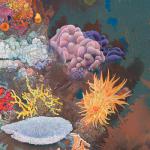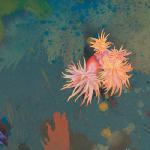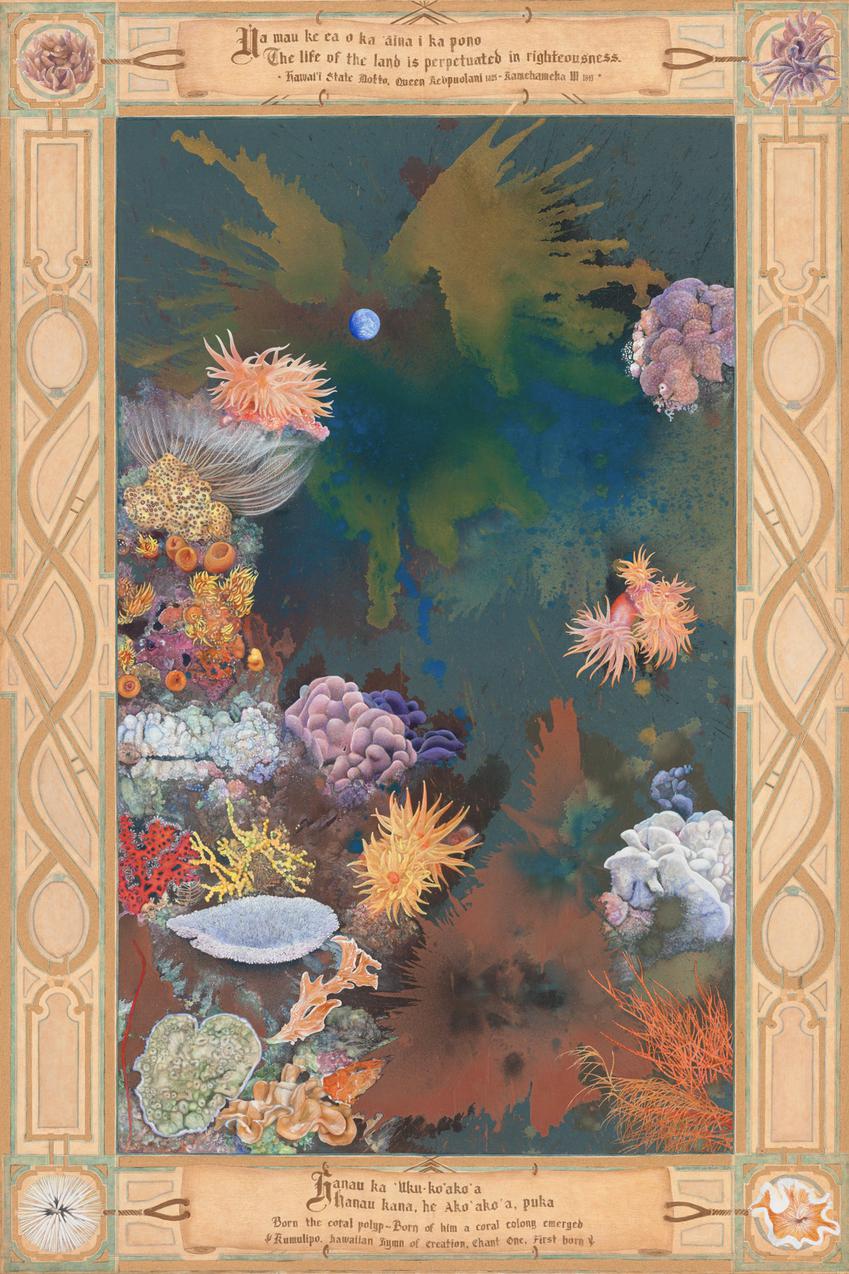An International Traveling Exhibition
by Calley O'Neill and the Rama Team, Featuring Rama, the Artist Elephant
A JOURNEY OF ART AND SOUL FOR THE EARTH
RAMA: AMBASSADOR FOR THE ENDANGERED ONES
Speaking Passionately on Behalf of Those who Cannot Speak
30% NO-TAKE ~ PRESERVING THE WORLD'S CORAL REEFS
by Calley O’Neill and Rama the Elephant with Jeb Barsh
Ua mau ke ea o ka ‘aina I ka pono.
The life of the land is perpetuated in righteousness.
Hawai’i State Motto, Queen Ke’opuolani, 1825 ~ Kamehameha III, 1843
Thus reads the banner at the top of the painting.
Hanau ka’uka-ko’ako’a
Hanau kana, he Ako’ako’a, puka
Born the coral polyp ~ Born of him a coral colony emerged
Kumulipo, Hawaiian Hymn of Creation, Chant One, First Born
Thus reads the banner on the bottom border of the painting.
This painting symbolizes the single magical full moon night each month when corals spawn. A prayer for the perpetuation of coral reefs, the painting spotlights Hawai’i’s reefs, developed in antiquity, isolation and warm subtropical water, forming several endemic species and rich species variations. Known as the rainforests of the sea, near shore reefs support 25% of the world’s sea life.
Teaming with life built over thousands of years, reefs are among the most biologically diverse habitats in the world. Comprising less than 1% of the Earth’s surface and 2% of the sea floor, reefs are home to thousands of species of fishes, crabs, shrimps, snails, sea worms, rays, marine reptiles, marine mammals, and top predators. Corals, a foundation species, are at once, animal, vegetable, and mineral. Made of communities of polyps, they build a mineral skeleton. Shallow warm water corals have single-celled photosynthesizing algae within, called zooxanthellae (zo-o-zan-THELL-ee) causing the beautiful coral color variations. Symbiotically, they share nutrients each other, allowing the coral to grow fast and build the enormous structures we know as reefs.
 | ||||
OCEAN HEALTH: The continuing decline of ocean health is one of the most serious and pervasive threats to a healthy future. About 1/3 of the world’s 700 species of coral are threatened with extinction, according to the IUCN Global Marine Species Assessment Project 2005-2015 study. This is a sharp increase from a decade ago. The major threats are overfishing, recreational activities, runoff, rising ocean temperatures and pollution. Coral has very low tolerance for temperature increases and increasing ocean acidification. Record warm ocean temperatures have caused massive bleaching events causing corals to die. It is essential to preserve a minimum of 20% of all coastal reefs as marine preserves to provide sanctuary for all reef species and replenish nearby reef ecosystems. Preserving 20% of the reefs will cost less than half what the government now gives as subsidies to dying fisheries. The federal government may protect 66 species of coral around the world, including several often found in Hawai’I. 59 of the species are found in the Pacific.
LACK OF KNOWLEDGE: Less than 3 - 5% of the ocean has been studied and mapped, and there is little information about the overall state of the ocean. This lack of knowledge is one of the biggest obstacles to ocean conservation, therefore a key in conserving reefs is swiftly increasing knowledge and public awareness. The International Union for the Conservation of Nature (IUCN) initiated the Global Marine Species Assessment Project 2005-2015 to address this lack of knowledge. The first global review of the threat of extinction for marine vertebrates, plant, and select invertebrates; 10,000 species were studied to establish a foundation for ocean conservation.
REEF BIOMASS PYRAMID ~ A FASCINATING REVERSAL: Reef studies and observations began after reefs were already seriously degraded, thus, the baseline of what we how we thought about pristine reefs was jaded. Marine Ecologist, Enric Sala turned the reef biomass pyramid upside down in a startling reversal of what scientists surmised about the populations that inhabit coral reefs. They thought there were a few top predators, lots of herbivores at the bottom, and some carnivores in between. Not true in a pristine coral reef! It turns out that the more top predators there are in a reef (up to 85% of the biomass) the more carnivores, herbivores, and plankton eaters there are. Plankton eaters are critical because they clean the reef.
DEEP SEA REEFS: Few people realize that fully two-thirds of coral species are to be found in the deep sea. In those depths, the reefs are ancient, some older than 8,500 years. Imagine, some have been building for over 25 million years. In the deep, coral thrives amidst a stunningly dramatic landscape, including the Earth’s longest and biggest mountain range, canyons, rivers, waterfalls, lakes, and fiery volcanoes.
Watch CHASING CORAL and if you love the oceans and the reefs, now is the time to get active, and get to work by teaming up with a reef/ocean conservation organization in your area!















